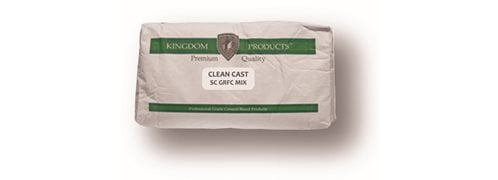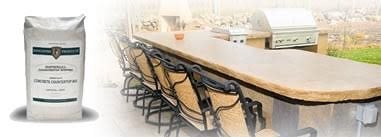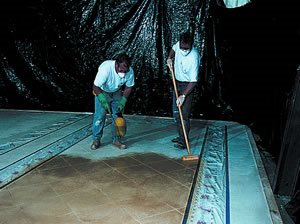- Concrete mix design
- Materials: What goes into the mix
- Concrete Slump
- Concrete mixes for hot weather
- Concrete mixes for cold weather
- Mix Designs for Different Types of Decorative Work
- Mixes for stamped concrete
- Mixes for stained concrete
- Mixes for concrete driveways
- Related Information:
- Concrete admixtures: Tips for using in the concrete mix
- Ordering concrete from ready-mix suppliers
- Concrete Mix Design in Southeast Asia
Staining Mixes
The basics of mix design also apply to stained concrete, although there are some characteristics to understand. Decorative concrete experts don't always agree, so we’ll give you the varying opinions and let you decide.
CONCRETE BASE
For stain jobs, you may or may not have any influence over the base concrete. If you do, a low-shrinkage, durable slab mix is the primary goal and there are really only a few things to be cautious about. In his second book, Guide to Stained Concrete Interior Floors, Bob Harris cautions against using calcium chloride accelerator since it can result in "dark, splotchy areas."
FLY ASH
Fly ash in staining mixes may reduce the color intensity a bit by reducing the amount of calcium hydroxide that the metallic salts in the stain react with. Calcium hydroxide is produced from portland cement. "Fly ash is a real benefit," says Bannister, "because it minimizes the free lime and therefore, the efflorescence. There's still plenty of cement to react with the stain. But you do like the more reactive cement, so you wouldn't use a leaner mix and superplasticizer; instead, go for the straight portland mix and reduce the water so there's not a lot of paste."
"I've had better success with a straight cement mix," says Harris. "I find when I get into pozzolanic materials, fly ash or slag, I get uncontrollable reactions. When you stain that with acid stain, it can turn out very splotchy and sporadic, kind of like concrete that contains calcium chloride."
EFFLORESCENCE
One of the worst things that can happen to your beautiful decorative job is to return a week later to see a white scum across the entire surface. This is especially common on stained floors with an acrylic sealer. As moisture moves through the concrete it picks up soluble salts. The sealer lets the moisture vapor pass through but not the salts, which form a white blush on the concrete. "Efflorescence is the nemesis of the stainer," says Doug Bannister. The keys to reducing the danger of efflorescence on your projects are to use fly ash in the mix, place a good vapor barrier beneath the slab if you have control over that part of the job (a real vapor barrier, not simply polyethylene sheeting), and to use low-permeability concrete (low w/c and fly ash).
CURING
Getting a good cure on the surface can also help reduce efflorescence by creating a denser surface layer, especially by using a cure and seal or curing blankets without added water. Using metakaolin in the mix can also reduce or eliminate efflorescence and can control alkali-silica reaction too.
 Clean Cast GFRC Mix
Available in white or gray, in 50lb bags
Clean Cast GFRC Mix
Available in white or gray, in 50lb bags
 Contractor-Pak
Contains six of our most effective admixtures
Contractor-Pak
Contains six of our most effective admixtures
 Imperial Countertop Mix
Engineered to be lightweight and strong. Minimal shrinkage.
Imperial Countertop Mix
Engineered to be lightweight and strong. Minimal shrinkage.
 Butterfield Cantera Wall Mix
Just Add Water
Butterfield Cantera Wall Mix
Just Add Water
 Integral Color + Fiber
Brickform Ultra-M1x blends pigments and reinforcement fibers
Integral Color + Fiber
Brickform Ultra-M1x blends pigments and reinforcement fibers
 NCA (Non-Chloride Accelerator)
All weather admixture
NCA (Non-Chloride Accelerator)
All weather admixture






